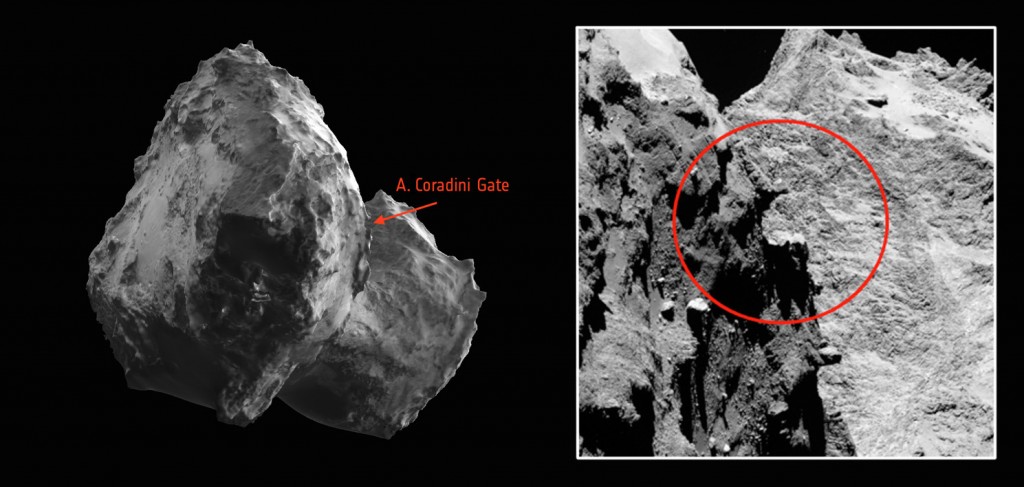Guest blog post by Matt Taylor, Rosetta Project Scientist.
At the most recent Rosetta Science Working Team meeting, held in Göttingen Germany in September 2015, a number of new science investigations were discussed, along with updates on on-going studies of Comet 67P/Churyumov-Gerasimenko and its environment.

Left: from ESA’s comet viewer https://sci.esa.int/comet-viewer; Right: ESA/Rosetta/MPS for OSIRIS Team MPS/UPD/LAM/IAA/SSO/INTA/UPM/DASP/IDA
This growing body of science and discovery has only been made possible through the dedication of hundreds of scientists and engineers across the globe, who have worked or still work on the mission.
For a project that has been going for almost 30 years, it is also regrettably inevitable that a few members of this large team have been outlived by the mission, including some who unfortunately did not live to appreciate the main comet phase.
As a token of deep gratitude and thanks, the Rosetta SWT has dedicated the upcoming special issue of scientific papers in Astronomy & Astrophysics to everyone who has worked on the mission, including those who continue to work on the mission, but especially those colleagues who have passed away.

Left: from ESA’s comet viewer https://sci.esa.int/comet-viewer; Right: ESA/Rosetta/MPS for OSIRIS Team MPS/UPD/LAM/IAA/SSO/INTA/UPM/DASP/IDA
As part of this recognition, the SWT has also dedicated two features on the comet to two esteemed colleagues who have passed away in recent years.
These features are the C. Alexander Gate, found on the smaller lobe, dedicated to Dr Claudia J. Alexander, the US Rosetta Project Scientist who passed away in July this year, and the A. Coradini Gate, located on the larger lobe, after Dr Angioletta Coradini, the former Principal Investigator of the VIRTIS instrument, who passed away in September 2011.
The two features were chosen for their prominence on Comet 67P/C-G, and for their very distinctive and striking gate-like appearances, considered to be highly appropriate monuments for our absent colleagues.
Matt also announced the dedication during the opening ceremony of the European Planetary Science Congress today.









Discussion: 7 comments
This is very touching. A beautiful tribute, they will be remembered.
I wish to be very careful with this. I am certain that people meant very well with these dedications, and that the women involved deeply deserve memorializing.
But this is a comet–it is rapidly approaching the sun. And we are just as likely to see these interesting gate features blasted or melted once it begins its inner cycle of the sun.
A kind, but sadly, temporary in the extreme, measure of memorial. Perhaps it wil be good to think of their symbols as well as their souls, free to sail on the solar wind. That will be as close to eternity as these dedications could hope for.
Comet 67P passed perihelion in August, so there is some chance that these memorials will last physically until next perihelion in about six and a half years time.
Atlantis is just a few words in an ancient book. Forever remembered.
This is so moving! I’ve actually got tears in my eyes as I write this.
By one of those odd coincidences, a course I’m doing on the history of the Ancient Near East is currently studying Egyptian religion, so some of the gods featured on 67P/C-G are becoming more into focus.
I love the idea that, in a way, dear Claudia and Angioletta will now spend eternity with the gods on Rosetta’s comet.
Thanks Matt and all the Souls deciding about this. When Claudia’s was thinking of the pillar conforming base of Ducky’s neck. Alexander’s and Coradini’s Gates. Life itself inverted in space exploration, our future. Love to families and work mates.
_With a grain of salt, but lovely written:
https://www.thedailybeast.com/articles/2015/10/08/meet-claudia-alexander-nasa-badass-who-never-got-her-due.html